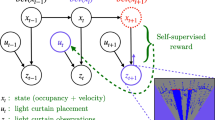Abstract
We describe a wheeled robotic system which navigates along outdoor “trails” intended for hikers and bikers. Through a combination of appearance and structural cues derived from stereo omnidirectional color cameras and a tiltable laser range-finder, the system is able to detect and track rough paths despite widely varying tread material, border vegetation, and illumination conditions. The approaching trail region is efficiently segmented in a top-down fashion based on color, brightness, and/or height contrast with flanking areas, and a differential motion planner searches for maximally-safe paths within that region according to several criteria. When the trail tracker’s confidence drops the robot slows down to allow a more detailed search, and when it senses a dangerous situation due to excessive slope, dense trailside obstacles, or visual trail segmentation failure, it stops entirely to acquire and analyze a ladar-derived point cloud in order to reset the tracker. Our system’s ability to negotiate a variety of challenging trail types over long distances is demonstrated through a number of live runs through different terrain and in different weather conditions.
Access this chapter
Tax calculation will be finalised at checkout
Purchases are for personal use only
Similar content being viewed by others
References
S. Thrun, M. Montemerlo, et al., Stanley the robot that won the DARPA grand challenge. J. Field Robot. 23(9), 661–692 (2006)
C. Urmson et al., A robust approach to high-speed navigation for unrehearsed desert terrain. J. Field Robot. 23(8), 467–508 (2006)
A. Huang, D. Moore, M. Antone, E. Olson, S. Teller, Multi-sensor lane finding in urban road networks, in Robotics: science and systems (Zurich, Switzerland, 2008)
C. Urmson et al., Autonomous driving in urban environments: Boss and the urban challenge. J. Field Robot. 25(1) (2008)
M. Blas, M. Agrawal, K. Konolige, S. Aravind, Fast color/texture segmentation for outdoor robots, in Proceedings of the international conference in intelligent robots and systems (2008)
G. Grudic , J. Mulligan, Outdoor path labeling using polynomial mahalanobis distance, in Robotics: science and systems (2006)
C. Armbrust, T. Braun, T. Fohst, M. Proetzsch, A. Renner, B. Schafer, K. Berns, “Ravon—the robust autonomous vehicle for off-road navigation”, in IARP Workshop on Robotics for Risky Interventions & Environmental Surveillance (2009)
P. Santana, N. Alves, L. Correia, and J. Barata, Swarm-based visual saliency for trail detection, in Proceedings of the international conference in intelligent robots and systems (2010)
C. Rasmussen, Y. Lu, M. Kocamaz, Trail following with omnidirectional vision, in Proceedings of the international conference in intelligent robots and systems (2010)
C. Rasmussen, Y. Lu, M. Kocamaz, Integrating stereo structure for omnidirectional trail following, in Proceedings of the international conference in intelligent robots and systems (2011)
A. Blake, M. Isard, Active Contours (Springer-Verlag, 1998)
C. Rasmussen, Y. Lu, M. Kocamaz, Appearance contrast for fast, robust trail-following, in Proceedings of the international conference in intelligent robots and systems (2009)
Y. Rubner, C. Tomasi, L. Guibas, A metric for distributions with applications to image databases, in Proceedings of the international conference in intelligent robots and systems (1998)
G. Mori, Guided model search using segmentation, in Proceedings of the international conference in computer vision (2005)
D. Scaramuzza, Omnidirectional vision: from calibration to robot motion estimation (Ph.D. dissertation, ETH Zurich, Switzerland, 2008)
M. Lourakis, levmar: Levenberg-Marquardt nonlinear least squares algorithms in C/C++ (2009), http://www.ics.forth.gr/ lourakis/levmar/. Accessed Nov 2009
N. Winters, J. Gaspar, G. Lacey, J. Santos-Victor, Omni-directional vision for robot navigation, in IEEE Workshop on Omnidirectional Vision (2000)
H. Koyasu, J. Miura, Y. Shirai, Realtime omnidirectional stereo for obstacle detection and tracking in dynamic environments, in Proceedings of the international conference in intelligent robots and systems (2001)
S. Lin, R. Bajcsy, High resolution catadioptric omni-directional stereo sensor for robot vision, in Proceedings of the international conference in intelligent robotics and automation (2003)
H. Hirschmuller, Stereo processing by semi-global matching and mutual information, IEEE Trans. Pattern Anal. Mach. Intell 25(2), 328–341 (2008)
M. Maimone, C. Leger, J. Biesiadecki, Overview of the mars exploration rovers autonomous mobility and vision capabilities, in ICRA Space Robotics Workshop (2007)
S. LaValle, Planning Algorithms (Cambridge University Press, Cambridge, England, 2006)
D. Ferguson, T. Howard, M. Likhachev, Motion planning in urban environments: Part I, in Proceedings of the international conference in intelligent robots and systems (2008)
R. Simmons, Inter Process Communication (IPC) library (2012), http://www.cs.cmu.edu/~ipc. Accessed Jan 2012
C. Rasmussen, Shape-guided superpixel grouping for trail detection and tracking, in Proceedings of the international conference in intelligent robots and systems (2008)
Acknowledgments
The authors gratefully acknowledge the support of the National Science Foundation under award 0546410.
Author information
Authors and Affiliations
Corresponding author
Editor information
Editors and Affiliations
Rights and permissions
Copyright information
© 2014 Springer-Verlag Berlin Heidelberg
About this chapter
Cite this chapter
Rasmussen, C., Lu, Y., Kocamaz, M. (2014). A Trail-Following Robot Which Uses Appearance and Structural Cues. In: Yoshida, K., Tadokoro, S. (eds) Field and Service Robotics. Springer Tracts in Advanced Robotics, vol 92. Springer, Berlin, Heidelberg. https://doi.org/10.1007/978-3-642-40686-7_18
Download citation
DOI: https://doi.org/10.1007/978-3-642-40686-7_18
Published:
Publisher Name: Springer, Berlin, Heidelberg
Print ISBN: 978-3-642-40685-0
Online ISBN: 978-3-642-40686-7
eBook Packages: EngineeringEngineering (R0)




